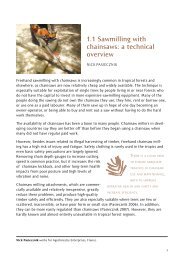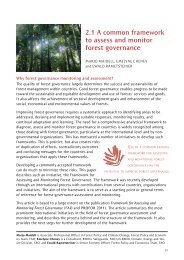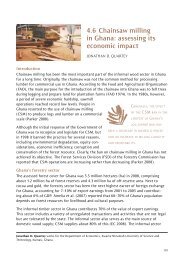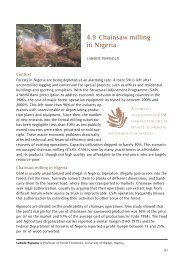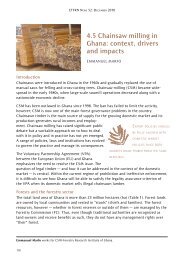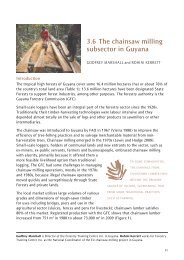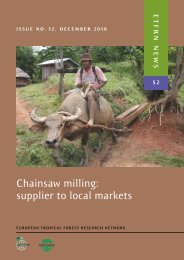Chainsaw milling: supplier to local markets - European Tropical ...
Chainsaw milling: supplier to local markets - European Tropical ...
Chainsaw milling: supplier to local markets - European Tropical ...
You also want an ePaper? Increase the reach of your titles
YUMPU automatically turns print PDFs into web optimized ePapers that Google loves.
4.11 chaiNsaw milliNg iN ugaNDa<br />
pit-sawyers harvest in the natural forests and woodlands, where they are licensed as<br />
individuals or associations (odokonyero 2005a; mwlE 2002). Their activities are<br />
restricted, especially in reserves, because they are difficult <strong>to</strong> control and regulate; the<br />
majority of pit-sawyers work on private land. They may damage the forests and their <strong>to</strong>ols<br />
are inadequate for hardwood logs (odokonyero 2005a).<br />
They produce most of the timber on the market.<br />
The sawmill industry in uganda is mobile and plantationbased.<br />
odokonyero (2005a) noted that the conservation<br />
sentiment in uganda does not favour large static sawmills<br />
since forests are small and scattered and the use of them<br />
is restricted. moreover, the current annual allowable Cut<br />
(150,000–200,000 m 3 ) can sustain only small mobile sawmills<br />
and pit-sawing.<br />
until recently, there has been a standing ban on the use of<br />
chainsaws in timber processing. Their use has been limited <strong>to</strong> felling and cross-cutting<br />
operations; they are considered wasteful when used for ripping. The chainsaw is an<br />
important <strong>to</strong>ol for timber production on private lands, however, especially on farmland<br />
and woodlands where control is limited. in addition, some opera<strong>to</strong>rs now transport billets,<br />
disguised as firewood, <strong>to</strong> urban centres, where they convert them <strong>to</strong> timber using chainsaws<br />
and bench sawmills.<br />
chainsaw lumber production<br />
Policy and legislative framework<br />
The policy and regula<strong>to</strong>ry framework for the forest sec<strong>to</strong>r in uganda is contained in the<br />
uganda Forest policy, the national Forest plan and in the National Forestry and Tree<br />
Planting Act. This framework enables the Government of uganda <strong>to</strong> promote a modern,<br />
competitive, efficient and well-regulated forest industry (mwlE 2002).<br />
The forest sec<strong>to</strong>r is coordinated by the Forest inspection Division (FiD), which supervises<br />
the nFa and the DFs. regulations for timber production are set by the FiD and<br />
implemented by the DFs and nFa within their areas of jurisdiction. Timber production<br />
regulations restrict the use of chainsaws <strong>to</strong> felling and cross-cutting operations. it is<br />
illegal <strong>to</strong> use them for freehand ripping operations. <strong>Chainsaw</strong>s are permitted if the owner<br />
uses <strong>milling</strong> attachments, registers with the nFa and pays the relevant fees. Criteria for<br />
permitting improved chainsaw <strong>milling</strong> (Csm) are evenness and smoothness of cut and<br />
limited waste.<br />
Distribution and marketing<br />
Timber is marketed in uganda through formal and informal channels. The formal<br />
market is controlled and regulated through taxes on harvest, movement permits and<br />
market taxes. This regulation is difficult <strong>to</strong> apply <strong>to</strong> the informal market, which mainly<br />
comprises illegal timber producers. most of the timber in the informal market originates<br />
in forests on private land. Forest regulations are not strictly enforced when it comes <strong>to</strong><br />
197



